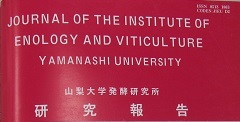

 |
山梨大学醗酵研究所 研究報告[1454年-1997年] JOURNAL OF THE INSTITUTE OF ENOLOGY AND VITICULTURE |
| vol.14 (1970) |
|
「低亜硫酸含有白ブドウ酒の製造に関する基礎的研究
(第1報) PVPP による 脱ポリフェノール処理の甲州種白ブドウ酒に及ぼす影響について 」 Fundamental Studies on the Production of the Stable White Wine Involved Low Amount of Sulphur Dioxide Part 1. Effects of PVPP Fining on Polyphenol Composition and Characteristics of Koshu White Table Wine 小泉智恵子, 櫛田忠衛 (昭和45年2月10日受理) Tieko KOIZUMI and Tadae KUSHIDA pp.1-13[PDF] |
| By the fining of Koshu white table wine with insoluble synthetic resin, PVPP (Polyvinyl-polypyrrolidone), the color was faded about fifty percent, and the browning was almost prevented for three months, while the Sulphur dioxide was rapidly decreased. The polyphenols of smaller molecule such as leucoanthocyanin and catechin were removed and the composition of residual polyphenols was imitated that of the old wine aged for several years, and the taste of the wine was improved. Moreover, by this treatment, alcohol, reducing sugar, total acid, iron and potassium were little affected, and copper and bound Sulphur dioxide were decreased a little, while protein was absorbed and removed completely. |
|
「ブドウ酒に樹脂処理を応用する研究 色調と成分に及ぼす影響」
Studies on the Application of Ion Exchange Process to the Wine Industry Effect of Resin Treatment on the Removal of Color and Wine Constituents 天野義文,松野 広,加賀美元男 Yoshifumi AMANO, Hiroshi MATSUNO and Motoo KAGAMI pp.15-22[PDF] |
|
The effects of four synthetic resins. Nylon 6 powder, Vinyl Chloride powder, Duolite S-30 and Asmit 173 N, on color removal and wine constituents were investigated.
The experimental results obtained were summarized as the following three items. 1) Nylon 6 powder and Asmit 173 N had more excellent decolorizing ability than the other two. 2) The decoloring effects exhibited by resin treatment became stronger in proportion to the contribution ratio in each wave length. 3) The preventing effect of resin treatment from browning of the wine was recognized, because browning of the wine treated with resin was not so remarkable as the untreated wine. |
|
「ピロ炭酸ヂエチルエステルによる食品および醸造物の殺菌に関する研究
(第1報) ピロ炭酸ヂエチルエステルによる各種微生物の殺菌」 Studies on the Sterilization of Food and Wine by Diethylpyrocarbonate Part 1. On the Sterilization of Microorganisms by Diethylpyrocarbonate. 後藤 昭二・山川祥秀・横塚勇 Shoji GOTO, Yoshihide YAMAKAWA and Isami YOKOTSUKA pp.23-33[PDF] |
|
ピロ炭酸ヂエチルエステル (DEPC) による微生物の殺菌作用に影響を及ぼす二,三の因子とブドウ酒醸造に関与する酵母, 細菌類のほか多数の酵母,細憲,カビ類に対する殺菌効果を検討した。
1. 酵母菌数が 104~10⁵cells/mlの場合, DEPC25ppmの使用で,2~8時間後に完全殺菌されるが,菌数が10%になると,完全殺菌のためには50ppmを要した。 2. DEPCの殺菌作用は懸濁培地のpHが酸性側で効果的であり,中性~アルカリ側で効果が認められなかった。 3. 有機窒素の存在はDEPC の殺菌作用を阻害した。しかし,アルコール,有機酸,食塩等は影響を及ぼさなかった。 4. 生理食塩水に懸濁した酵母はDEPC 20ppmで2時間後完全殺菌された。しかし,子嚢胞子は強い抵抗性を示した。 5. 大部分の細菌類はDEPC20ppmで2時間後完全殺菌されたが,有胞子のBacillusおよび Clostridium,その他二,三の細菌は強い抵抗性を示し,DEPC1,000ppmでも完全殺菌されなかった。また,乳酸菌群の完全殺菌には50~100ppmを要した。 6. DEPCのカビ類に対する殺菌効果は極めて少なかった。 The sterilizing efficiency of diethylpyrocarbonate (DEPC) against microorganisms in grape juice, wine and synthetic medium and several factors which diminish antimicrobial effect of DEPC were studied. 1. The lethal concentration of DEPC depended on the number of microorganisms present; in the solution which contained yeast cells 104–105 per ml, the lethal concentration of DEPC was 25ppm, but in the 107cells per ml; 50ppm of DEPC was required as the lethal concentration. 2. The sterilizing efficacy of DEPC was comparatively strong in the acidic solution, but ineffective in neutral or alkaline solution. It was reduced by organic nitrogen of comparatively high concentrations, but not diminished by neither alcohol, organic acids nor sodium chloride. 3. Vegetative yeast cells which were suspended in physiological saline were killed by DEPC at the concentration of 20 ppm within two hours after addition, but ascospores had strong resistivity against DEPC; they were not completely killed at the concentration of 35 ppm. 4. The majority of bacteria was killed at the concentration of 20 ppm, but Bacillus, Clostridium and a few other bacteria had strong resistivity; they were not completely killed at the concentration of 1000 ppm. Also the concentration of 50–100ppm of DEPC were required to kill lactic acid bacteria. DEPC had almost no effect on mold. |
|
「ピロ炭酸ヂエチルエステルによる食品および醸造物の殺菌に関する研究
(第2報) ピロ炭酸ヂエチルエステル添加ブドウ酒からの炭酸ヂエチルの生成およびそれが酒質に及ぼす影響」 Studies on the Sterilization of Food and Wine by Diethylpyrocarbonate Part 2. On the Formation of Diethylcarbonate in DEPC-added Wine and the Brandy made from DEPC-added Wine and their Organoleptic Examination 後藤昭二,山川祥秀,横塚勇 Shoji GOTO, Yoshihide YAMAKAWA and Isami YOKOTSUKA. Pp35-41[PDF] |
|
ピロ炭酸ヂエチルエステル(DEPC)を添加したブドウ酒および果汁中の炭酸ヂエチル(DAC)の存在の確認と添加DEPCからのDACの生成率とをガスクロマトグラフィーおよび赤外線吸光分析法により,また,DEPC添加ブドウ酒の蒸留によって製造したブランデー中へのDACの移行について研究した。一方,DEPC 添加ブドウ酒およびブランデーの官能試験を行ない,DEPC添加量と酒質との関係について検討した。
DEPC添加ブドウ酒および果汁中にDACの存在が確認され,また, DACの生成率はブドウ酒中で6.4~6.6%,果汁中では4.8%であった。ブランデー中へはブドウ酒中のDACの80%が移行した。 ブドウ酒にDEPCを添加するとき100ppm以下でのみ酒質に影響がなく,また,ブランデー用ブドウ酒への使用は100ppm以下で製品ブランデーに影響を及ぼさなかった。 Detection and the formation rate of diethylcarbonate (DAC) in diethylpy rocarbonate (DEPC)-added-wine or -must were studied by gaschromatographic and IR-spectrophotometric analysis. The rate of DAC formation is 6.4-6.6 % in the table wines and 4.8% in the must. The amount of DAC moved to the brandy which was distilled from DEPC added-wine was about 80% of DAC in the original wine. By their organoleptic examination, it was confirmed that the flavor of wine was not deteriorated by the use of DEPC less than 100ppm. |
|
「乳酸菌検出用培地への有胞子乳酸菌の生育」
中山大樹 pp. 43-49[PDF] |
|
乳酸菌のみが選択的に生育するとされている乳酸菌簡易検出用中川培地に有胞子乳酸菌 が生育するか否かをしらべたところ,各群を代表する9株の有胞子乳酸菌の栄養細胞は,いずれも中川培地に生育した。
有胞子乳酸菌の胞子を中川培地に接種し,加熱して栄養細胞を殺して培養すると,14日 培養しても生育しないものが多く,生育するものも,102/5mlの接種の場合生育がはじまるのに8日以上を要した。 12点の土壌を中川培地に接種し,煮沸後培養したところ,8点は混濁を生じ,これら,すべてから有胞子乳酸菌Bacillus coagulansが分離された。その内1株は,鞭毛を欠除した変種であった。 |
The Institute of Enology and Viticulture, University of Yamanashi 所在地:〒400-0005 山梨県甲府市北新1丁目114 |
ホ-ムペ-ジに掲載の文章・記事・写真・図表などの無断転載を禁止します。